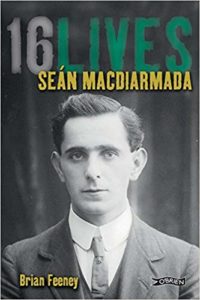 Reviewer: Wouter van Dijk
Reviewer: Wouter van Dijk
Seán MacDiarmada, Brian Feeney
16 Lives series
The O’Brien Press, Dublin 2014
ISBN: 978 1 84717 263 1
Paperback, illustrated in black and white, with map, timeline, notes, bibliography and index
336 pages
€ 14,99
The life of Seán MacDiarmada
The uprising that broke out in Dublin and some other places in Ireland in 1916 was largely directed by two people; Tom Clarke and Seán MacDiarmada. In popular history, the focus is on Patrick Pearse as provisional president of the Republic of Ireland, and James Connolly the charismatic workers' leader. In the background, however, the conspirators Clarke and MacDiarmada played a much larger role in organizing and planning the Rising.
Perhaps the most important role was reserved for MacDiarmada (1883-1916). The struggle for a violent revolt to free Ireland from the English yoke had been part of the goals of the secret Irish Republican Brotherhood (IRB) since its beginnings. Clarke was an important nestor in the movement around 1900, who had spent years in prison for the Irish cause. MacDiarmada was the 'coming man' who dedicated everything in his life to bringing about an independent Ireland. Because Clarke was released conditionally in the years prior to the uprising, he could not actively participate in activities for the IRB, the practical work of organizing and arranging largely came to lie on the shoulders of MacDiarmada.
That said, we have to make a little jump back in time. This book by Brian Feeney is after all a complete biography of MacDiarmada that also describes his years before the planning of the Easter Rising. The book is published in the 16 Lives series, of which we previously discussed the part about Michael Mallin. This series was issued in the run-up to the centennial commemoration of the Easter Rising in 2016 and consists of biographies of leaders of the uprising who were executed after the end of it. Feeney describes MacDiarmada's entire, rather short life. He spent his childhood in the county of Leitrim in the northwest of Ireland. Like many regions in the country, it was a very poor area at the time. MacDiarmada hoped to flee poverty by becoming a teacher. However, the facilities for training and preparation for the obligatory state exam were not ideal, and MacDiarmada was not an exceptionally gifted student. After an unsuccessful attempt to pass the exam, he went to Belfast in 1905, which at the time acted as a magnet for job seekers from all over the country. Belfast was a fast-growing industrial city that offered a lot of employment in these years.
It was in Belfast that MacDiarmada became acquainted with Bulmer Hobson and Denis McCullough, who initiated him into the IRB and awakened his national consciousness. MacDiarmada went to work for the republican cause, under the cover of popularizing moderate nationalist Dungannon Clubs. A few years later, the Dungannon Clubs merged with Arthur Griffith's Sinn Féin and MacDiarmada became an important organizer for this political movement. Under the surface, however, he spread his network for the IRB. Because he travelled the country in person and met with people everywhere, the ties that were forged this way were of a personal nature, with MacDiarmada acting as a spider in the web. Meanwhile, he swore the people he thought fit for it into the IRB, so that in fact a network of IRB members arose under the cover of more moderate nationalistic organizations. It was also through this network that MacDiarmada could make many of his preparations for the Easter Rising.
The research on MacDiarmada was difficult, Feeney explains in his book. MacDiarmada was extremely careful because he was constantly aware of the fact that he was shadowed and followed by police and secret services. Partly because of this he hardly wrote anything down, which makes the investigation into him and his motives difficult. What becomes clear from Feeney's book is how central the role of MacDiarmada has been in planning the uprising. He was probably the most important factor in this. Together with Tom Clarke he directed the highest echelons of the IRB, but because Clarke could do little in practice because of the risk of re-arrest, MacDiarmada was the most defining man in the game. There cannot be read much about the private life of MacDiarmada in the book, for the simple reason that he spent all his time in advancing the nationalist cause. Feeney's book provides a reassessment of the central position that MacDiarmada played in the organization of the uprising. The book is written in an accessible manner and therefore highly recommended for anyone who wants to know more about the people who were behind the Easter Rising and how they organized and participated in the Rising.
Wouter van Dijk
